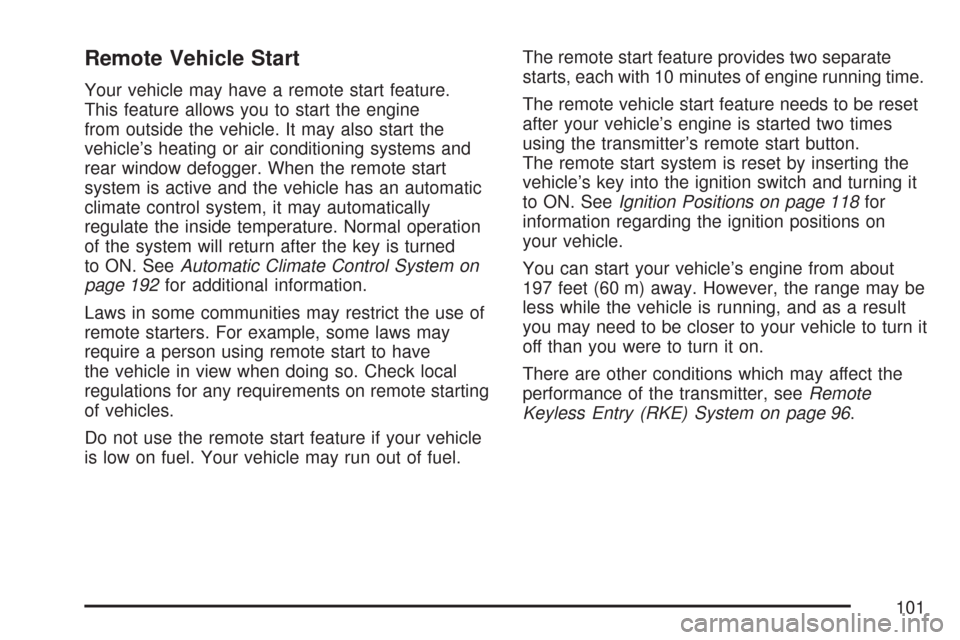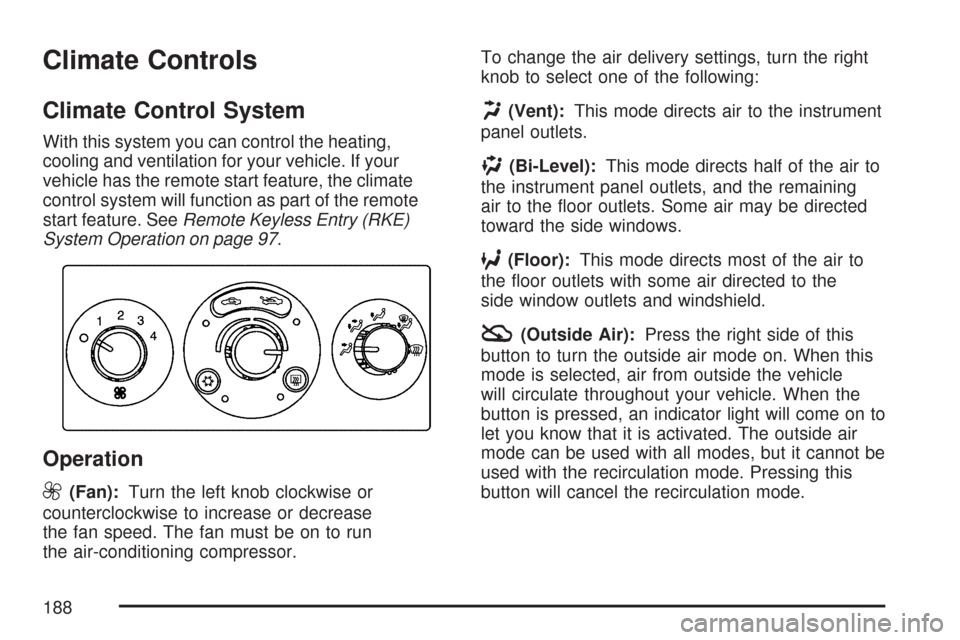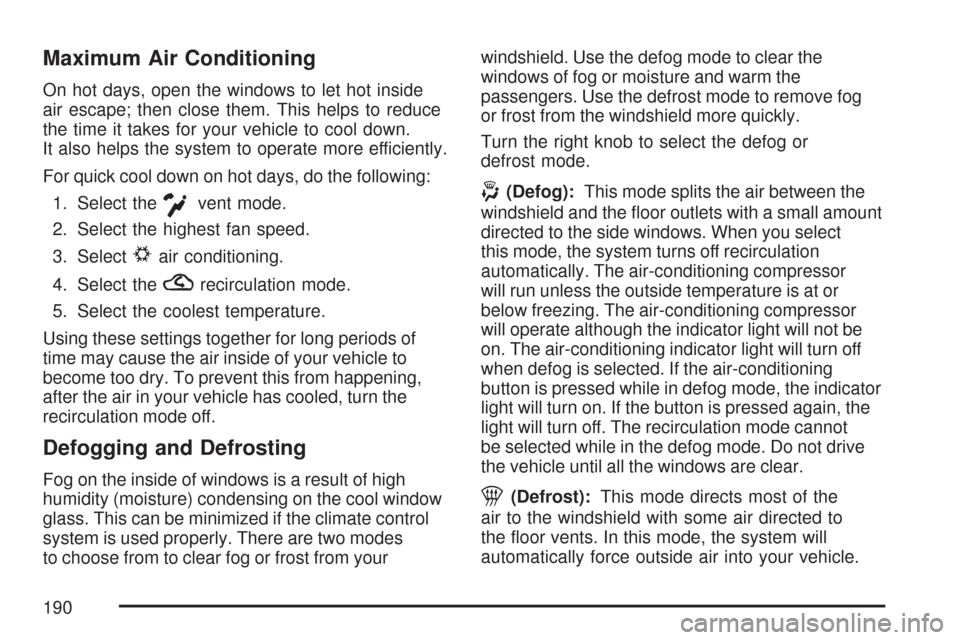2007 CHEVROLET MALIBU air condition
[x] Cancel search: air conditionPage 41 of 510

Safety Belt Pretensioners
Your vehicle has safety belt pretensioners for the
driver and right front passenger. Although you
cannot see them, they are part of the safety belt
assembly. They help tighten the safety belts during
the early stages of a moderate to severe frontal
and near frontal crash if the threshold conditions
for pretensioner activation are met. And, if your
vehicle has side impact airbags, safety belt
pretensioners can help tighten the safety belts
in a side crash.
Pretensioners work only once. If they activate in
a crash, you will need to get new ones, and
probably other new parts for your safety belt
system. SeeReplacing Restraint System Parts
After a Crash on page 91.
Safety Belt Extender
If the vehicle’s safety belt will fasten around you,
you should use it.
But if a safety belt is not long enough, your
dealer/retailer will order you an extender. When
you go in to order it, take the heaviest coat you will
wear, so the extender will be long enough for
you. To help avoid personal injury, do not
let someone else use it, and use it only for the
seat it is made to �t. The extender has been
designed for adults. Never use it for securing child
seats. To wear it, attach it to the regular safety
belt. For more information, see the instruction
sheet that comes with the extender.
41
Page 82 of 510

Passenger Sensing System
Your vehicle has a passenger sensing system for
the right front passenger’s position. The passenger
airbag status indicator will be visible when you start
your vehicle in the instrument panel.
The words ON and OFF, or the symbol for on
and off, will be visible during the system check.
If you are using remote start to start your vehicle
from a distance, if equipped, you may not see
the system check. When the system check
is complete, either the word ON or the word OFF,
or the symbol for on or the symbol for off, will
be visible. SeePassenger Airbag Status Indicator
on page 203.The passenger sensing system will turn off the
right front passenger’s frontal airbag under certain
conditions. The driver’s airbags are not part of
the passenger sensing system.
The passenger sensing system works with
sensors that are part of the right front passenger’s
seat. The sensors are designed to detect the
presence of a properly-seated occupant and
determine if the passenger’s frontal airbag should
be enabled (may in�ate) or not.
Accident statistics show that children are safer
if they are restrained in the rear rather than
the front seat.
We recommend that children be secured in a
rear seat, including: an infant or a child riding in
a rear-facing child restraint; a child riding in a
forward-facing child seat; an older child riding
in a booster seat; and children, who are large
enough, using safety belts.
United StatesCanada
82
Page 101 of 510

Remote Vehicle Start
Your vehicle may have a remote start feature.
This feature allows you to start the engine
from outside the vehicle. It may also start the
vehicle’s heating or air conditioning systems and
rear window defogger. When the remote start
system is active and the vehicle has an automatic
climate control system, it may automatically
regulate the inside temperature. Normal operation
of the system will return after the key is turned
to ON. SeeAutomatic Climate Control System on
page 192for additional information.
Laws in some communities may restrict the use of
remote starters. For example, some laws may
require a person using remote start to have
the vehicle in view when doing so. Check local
regulations for any requirements on remote starting
of vehicles.
Do not use the remote start feature if your vehicle
is low on fuel. Your vehicle may run out of fuel.The remote start feature provides two separate
starts, each with 10 minutes of engine running time.
The remote vehicle start feature needs to be reset
after your vehicle’s engine is started two times
using the transmitter’s remote start button.
The remote start system is reset by inserting the
vehicle’s key into the ignition switch and turning it
to ON. SeeIgnition Positions on page 118for
information regarding the ignition positions on
your vehicle.
You can start your vehicle’s engine from about
197 feet (60 m) away. However, the range may be
less while the vehicle is running, and as a result
you may need to be closer to your vehicle to turn it
off than you were to turn it on.
There are other conditions which may affect the
performance of the transmitter, seeRemote
Keyless Entry (RKE) System on page 96.
101
Page 145 of 510

OnStar®service is provided to you subject to
the OnStar®Terms and Conditions. You
may cancel your OnStar®service at any time by
contacting OnStar®as provided below. A complete
OnStar®Owners Guide and the OnStar®Terms
and Conditions are included in the vehicle’s
OnStar
®Subscriber glove box literature. For
more information, visit onstar.com or onstar.ca,
contact OnStar
®at 1-888-4-ONSTAR
(1-888-466-7827) or TTY 1-877-248-2080, or
press the OnStar
®button to speak with an
OnStar®advisor 24 hours a day, 7 days a week.
Not all OnStar
®features are available on all
vehicles. To check if your vehicle is equipped to
provide the services described below, or for a
full description of OnStar
®services and system
limitations, see the OnStar®Owner’s Guide in
your glove box or visit onstar.com.
OnStar®Services
For new vehicles with OnStar®, the Safe & Sound
Plan, or the Directions & Connections®Plan is
included for one year from the date of purchase.
You can extend this plan beyond the �rst year,
or upgrade to the Directions & Connections
®Plan.For more information, press the OnStar
®button to
speak with an advisor. Some OnStar®services
(such as Remote Door Unlock or Stolen Vehicle
Location Assistance) may not be available
until you register with OnStar
®.
Available Services with
Safe & Sound®Plan
Automatic Noti�cation of Airbag Deployment
Advanced Automatic Crash
Noti�cation (AACN) (If equipped)
Link to Emergency Services
Roadside Assistance
Stolen Vehicle Location Assistance
AccidentAssist
Remote Door Unlock/Vehicle Alert
OnStar®Vehicle Diagnostics
GM Goodwrench®On Demand Diagnostics
OnStar®Hands-Free Calling with
30 complimentary minutes
OnStar®Virtual Advisor (U.S. Only)
145
Page 188 of 510

Climate Controls
Climate Control System
With this system you can control the heating,
cooling and ventilation for your vehicle. If your
vehicle has the remote start feature, the climate
control system will function as part of the remote
start feature. SeeRemote Keyless Entry (RKE)
System Operation on page 97.
Operation
9
(Fan):Turn the left knob clockwise or
counterclockwise to increase or decrease
the fan speed. The fan must be on to run
the air-conditioning compressor.To change the air delivery settings, turn the right
knob to select one of the following:
H(Vent):This mode directs air to the instrument
panel outlets.
)(Bi-Level):This mode directs half of the air to
the instrument panel outlets, and the remaining
air to the �oor outlets. Some air may be directed
toward the side windows.
6(Floor):This mode directs most of the air to
the �oor outlets with some air directed to the
side window outlets and windshield.
:(Outside Air):Press the right side of this
button to turn the outside air mode on. When this
mode is selected, air from outside the vehicle
will circulate throughout your vehicle. When the
button is pressed, an indicator light will come on to
let you know that it is activated. The outside air
mode can be used with all modes, but it cannot be
used with the recirculation mode. Pressing this
button will cancel the recirculation mode.
188
Page 189 of 510

?(Recirculation):Press the left side of
the button to turn the recirculation mode on. When
recirculation mode is selected, the air inside the
vehicle will be recirculated through the climate
control system and the vehicle, not from outside
your vehicle. This mode is helpful when you
are trying to limit odors from entering your vehicle
and for maximum air conditioning performance
in hot weather. When the button is pressed,
an indicator light above the button will come on to
let you know that it is activated. The recirculation
indicator light will blink three times if you try to
use recirculation in a mode that it can not be
used in. Only use this mode when it is needed for
comfort, since window fogging will rapidly occur
if the air conditioning compressor is not engaged.
Pressing this button will cancel the outside air
mode. When you switch to the defog or defrost
modes the system will automatically move
from recirculation to outside air. When the vehicle
or fan is turned off and back on, the system
will default to outside air automatically. Only use
recirculation mode when it is needed for comfort,
since window fogging may occur.Temperature Control:Turn the center knob
clockwise or counterclockwise to increase
or decrease the temperature inside your vehicle.
When it’s cold outside 0°F (−18°C) or lower,
use the engine coolant heater, if equipped,
to provide warmer air faster to your vehicle.
An engine coolant heater warms the coolant
that the engine uses to provide heat to warm
the inside of your vehicle. For more information,
seeEngine Coolant Heater on page 122.
#(Air Conditioning):Press this button to turn
the air conditioning system on or off. When the
air conditioning button is pressed, an indicator light
will come on to let you know that air conditioning
is activated.
The air-conditioning system removes moisture
from the air, so you may sometimes notice a
small amount of water dripping underneath
your vehicle while idling or after turning off the
engine. This is normal.
189
Page 190 of 510

Maximum Air Conditioning
On hot days, open the windows to let hot inside
air escape; then close them. This helps to reduce
the time it takes for your vehicle to cool down.
It also helps the system to operate more efficiently.
For quick cool down on hot days, do the following:
1. Select the
Cvent mode.
2. Select the highest fan speed.
3. Select
#air conditioning.
4. Select the
?recirculation mode.
5. Select the coolest temperature.
Using these settings together for long periods of
time may cause the air inside of your vehicle to
become too dry. To prevent this from happening,
after the air in your vehicle has cooled, turn the
recirculation mode off.
Defogging and Defrosting
Fog on the inside of windows is a result of high
humidity (moisture) condensing on the cool window
glass. This can be minimized if the climate control
system is used properly. There are two modes
to choose from to clear fog or frost from yourwindshield. Use the defog mode to clear the
windows of fog or moisture and warm the
passengers. Use the defrost mode to remove fog
or frost from the windshield more quickly.
Turn the right knob to select the defog or
defrost mode.
-(Defog):This mode splits the air between the
windshield and the �oor outlets with a small amount
directed to the side windows. When you select
this mode, the system turns off recirculation
automatically. The air-conditioning compressor
will run unless the outside temperature is at or
below freezing. The air-conditioning compressor
will operate although the indicator light will not be
on. The air-conditioning indicator light will turn off
when defog is selected. If the air-conditioning
button is pressed while in defog mode, the indicator
light will turn on. If the button is pressed again, the
light will turn off. The recirculation mode cannot
be selected while in the defog mode. Do not drive
the vehicle until all the windows are clear.
1(Defrost):This mode directs most of the
air to the windshield with some air directed to
the �oor vents. In this mode, the system will
automatically force outside air into your vehicle.
190
Page 191 of 510

The air-conditioning compressor will run unless
the outside temperature is at or below freezing.
The air-conditioning compressor will operate
although the indicator light will not be on.
The air-conditioning indicator light will turn off
when defrost is selected. If the air-conditioning
button is pressed while in defrost mode, the
indicator light will turn on. If the button is pressed
again, the light will turn off. Recirculation cannot
be selected while in the defrost mode.
To help clear the windshield quickly, do the
following:
1. Select the defrost mode.
2. Select the highest temperature.
3. Select the highest fan speed.
Rear Window Defogger
The rear window defogger uses a warming grid
to remove fog or frost from the rear window.
come on to let you know that the rear window
defogger is activated. Be sure to clear as much
snow from the rear window as possible.If driving below 50 mph (80 km/h), the rear window
defogger will turn off about 15 minutes after the
button is pressed. If turned on again, the defogger
will only run for about seven minutes before
turning off. The defogger can also be turned off
by pressing the button again or by turning off
the engine.
If your vehicle’s speed is maintained above
50 mph (80 km/h), the rear window defogger
will remain on once the button is pressed.
If your vehicle has the remote start feature,
the rear defogger will automatically be turned on
if it is cold outside. When the vehicle transitions
out of the remote start mode, the rear defogger
will turn off. SeeRemote Keyless Entry (RKE)
System Operation on page 97.
Notice:Do not use anything sharp on the
inside of the rear window. If you do, you
could cut or damage the warming grid, and
the repairs would not be covered by your
warranty. Do not attach a temporary vehicle
license, tape, a decal or anything similar
to the defogger grid.
191